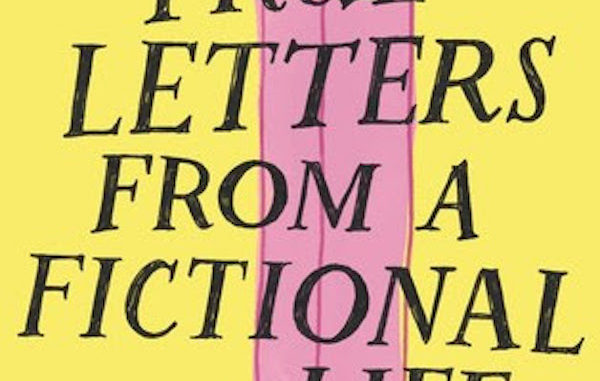
 As part of our ongoing collaboration with the Book House of Stuyvesant Plaza, our writers have accepted the challenge of reading and reviewing pre-publication review copies of highly anticipated young adult literature. The reviews are posted here for our readers, but also will be sent to the Book House where they will hopefully be used to inform customers about the books they may want to purchase.We will try to publish one review a week for the spring.
As part of our ongoing collaboration with the Book House of Stuyvesant Plaza, our writers have accepted the challenge of reading and reviewing pre-publication review copies of highly anticipated young adult literature. The reviews are posted here for our readers, but also will be sent to the Book House where they will hopefully be used to inform customers about the books they may want to purchase.We will try to publish one review a week for the spring.
The reviews contain spoilers, so be forewarned!
True Letters from a Fictional Life
by Kenneth Logan
Published June 2016
323 pages, Harper Collins
His family, sort-of girlfriend, and friends would all agree that James Lidell is the quintessential high school boy. A “good kid.” Below the surface, however, he displays traits that don’t exactly line up with his almost lackluster reputation of high-school athleteboy. James writes letters– letters he never intends to send– to the people in his life, and in doing so we see his true point of view: high-school confusedboy struggling to accept his own sexuality. Kenneth Logan, first-time author of True Letters from a Fictional Life writes James’ story of self-discovery in the first-person on his journey of acceptance, in turn encouraging an inevitably indecisive tone. It is this ambivalence that fuels the novel’s effectiveness in accurately depicting both the high school experience and the LGBT experience.
James’ story takes place in his rural Vermont hometown, where the high school experience is characterized by an unexciting school routine and parties that are most fun when the kids from New Hampshire show up. It is in this setting that we see James begin his journey. He realizes that he is having feelings directed towards his friend Hawken– the feelings he is supposed to be having for his not-so-girlfriend Theresa. His feelings for Hawken advance, and James, in a try-but-fail attempt at being casual, confesses how he feels to Hawken. “I continued, encouraged. ‘Everyone has a crush on you.’ ‘Oh yeah?.’ ‘Everyone.’ I tried to sound casual. Even me’”(9) This scene between the two boys certainly shows James testing the social waters– looking for validation, perhaps. However, it is also the beginning of James’ growing concern regarding his sexuality. In his trials of self-discovery James writes a letter that attempts to draw comparisons between himself and the Upper Valley’s resident gay kid, Aaron, but finds mainly differences. “He was sporting a typical Aarom Foster ensemble beneath his unbuttoned blue peacoat: tight white jeans and a purple T-Shirt.” (36) James concludes that he really isn’t that similar to Aaron, but this leaves him questioning who he is similar to. James’ group of friends, Mark, Derek, Breyer, are all people he feels close to, but don’t always leave him feeling warm and fuzzy, especially when they make comments such as “‘Aaron doesn’t just like boys,’ Derek said. ‘He really, really likes boys.’ And then he started laughing.” (64) In his eyes, James’ prospects weren’t looking up. This changes, however, when James meets Topher and hope is shed over his everlasting spiral of overthought and confusion. Not only is James now dating someone, he is also given an example of how he can have a happy, normal life.
James’ story continues with more of the same, but we now have this building relationship with Topher. Everything seems to be going well for James, until he finds out his letters were stolen. He had written letters to most of his friends, his teachers, coaches, even God. Not only does the thief steal the letters, they proceed to send them to James’ friends. This leads to more confusion and stress leads to an accusatory, sneaky James that the reader hasn’t really seen before. This is the eventual reason James is prompted to have honest conversations with his family and friends about his sexuality, making for a rocky, but happy end to the novel where James “Doesn’t care who’s watching” (323) when Topher has his arm around him.
What I foresee as a reviewer is that upon its publication, this novel will be critiqued for its simplistic writing style and dialogue. I think, however, that Logan does this purposefully, to allow the complicated characters and plotline to speak for themselves, and for the reader to take them at face value. This makes the book incredibly visceral and reading as accurate. An example of this equivocacy is when James agrees to run a 10 kilometer race against his friend, Derek. Mark and James have a rocky relationship, especially when James’ letters get stolen. This changes though, when James is honest with Mark and they make up. Afterwards, the two proceed to run the race, and, despite every fairy-tale plotline you’ve ever known, James loses the race to Mark. How terribly realistic is that? Often in the novel we see James making comments that, in my opinion, defy the unrealistically thought-out, impossibly well-spoken nature we see to some characters in literature. For example, on page 78, James chats with Theresa about cheesy inspirational posters: “ ‘Righteousness’ I hollered in my deepest tone. ‘Striving’ she boomed, shaking her fist. ‘Straightness’ I yelled. ‘Straightness?’ She laughed.’I mean, like, straight-laced. Straightahead?’ She laughed harder.” Rather than hearing James’ inner monologue here, Logan simply lets the moment speak for itself. And among James’ confused web of character ties and self-loathing, it speaks quiet volumes all by itself. The worth of this novel does not lie in its masked symbolism or exceptional writing, but rather in its exceptional averageness. None of this novel’s characters are particularly good or evil, they really just exist as different personas from which James is influenced. They are ambivalent as ever and it allows the story to be told. No interruptions. The high school LGBT experience, in my opinion, is not one that needs to be told through any sort of complicated story because of its already complicated nature. Its ambiguous approach is what allows this socially-charged novel to do a great job at navigating the mountainous terrain of secrets, authenticity, and telling the ever-inspiring journey of self-discovery.
My advice to a reader of True Letters From a Fictional Life is to keep an open mind to allow the novel to take it’s course. I see many readers immediately dismissing this novel because of its simplistic nature. It does spell most things out for you fairly clearly. Below this simplistic facade, however, lies an intermingled web of lies, relationships, and emotion, which make the novel feel very real. As real as a t The varying morales of its characters mean that there is, somewhere in the novel, the ever-sought-after “relatable” factor. The most important takeaway from this novel, though is the development of James as a person. While the coming-out experience isn’t one that most can directly relate to, the personal journey of James finding himself is one that many can.
